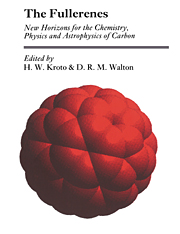Book contents
- Frontmatter
- Contents
- The evolution of the football structure for the C60 molecule: a retrospective
- Dreams in a charcoal fire: predictions about giant fullerenes and graphite nanotubes
- On the formation of the fullerenes
- Production and discovery of fullerites: new forms of crystalline carbon
- Systematics of fullerenes and related clusters
- The fullerenes: powerful carbon-based electron acceptors
- The carbon-bearing material in the outflows from luminous carbon-rich stars
- Elemental carbon as interstellar dust
- The pattern of additions to fullerenes
- Pollyynes and the formation of fullerenes
- Hypothetical graphite structures with negative gaussian curvature
- Fullerenes as an example of basic research in industry
- Deltahedral views of fullerene polymorphism
- Geodesic domes and fullerenes
The pattern of additions to fullerenes
Published online by Cambridge University Press: 03 February 2010
- Frontmatter
- Contents
- The evolution of the football structure for the C60 molecule: a retrospective
- Dreams in a charcoal fire: predictions about giant fullerenes and graphite nanotubes
- On the formation of the fullerenes
- Production and discovery of fullerites: new forms of crystalline carbon
- Systematics of fullerenes and related clusters
- The fullerenes: powerful carbon-based electron acceptors
- The carbon-bearing material in the outflows from luminous carbon-rich stars
- Elemental carbon as interstellar dust
- The pattern of additions to fullerenes
- Pollyynes and the formation of fullerenes
- Hypothetical graphite structures with negative gaussian curvature
- Fullerenes as an example of basic research in industry
- Deltahedral views of fullerene polymorphism
- Geodesic domes and fullerenes
Summary
Conjugation in C60 is not as extensive as was originally anticipated because, for various reasons, the pentagon rings avoid containing double bonds. As a consequence, there is extensive bond localization and the molecule, which is quite reactive, and displays superalkene rather than superaromatic properties. C70 behaves in a similar fashion; other fullerenes may follow suit. Additions predominate and C60 is particularly susceptible to nucleophilic attack. Added groups may also be readily replaced by nucleophiles, although the reaction mechanism is uncertain at present. The functionalized molecule tends to revert to the parent fullerene at moderate temperatures, and characterization of reaction products by mass spectrometry is thus particularly difficult. This fact, coupled with the complexity of the addition products, makes work with fullerenes exacting. A selection of reactions studied to date and the progress made towards identifying various patterns of addition are described.
Introduction
When spectroscopic evidence for the existence of C60 was first obtained, a view prevailed that it would be a very unreactive molecule. This conclusion was based on the assumption that with a possible 12500 resonance structures (Klein et al. 1986), C60 would be superaromatic. However, the earlier molecular orbital calculations (Bochvar & G'alpern 1973) correctly predicted that there would be substantial bond fixation in the molecule; more recently, the bond lengths have been determined by neutron diffraction studies to be 1.391 Å and 1.455 Å (David et al. 1991); other methods give similar values.
Thus C60 is a superalkene rather than a superarofnatic and readily undergoes additions. Bond fixation arises because structures with double bonds in pentagonal rings are unfavourable in chemistry, due probably to the increase in strain that would result from bdnd-shortening; this phenomenon…
- Type
- Chapter
- Information
- The FullerenesNew Horizons for the Chemistry, Physics and Astrophysics of Carbon, pp. 87 - 102Publisher: Cambridge University PressPrint publication year: 1993
- 4
- Cited by

